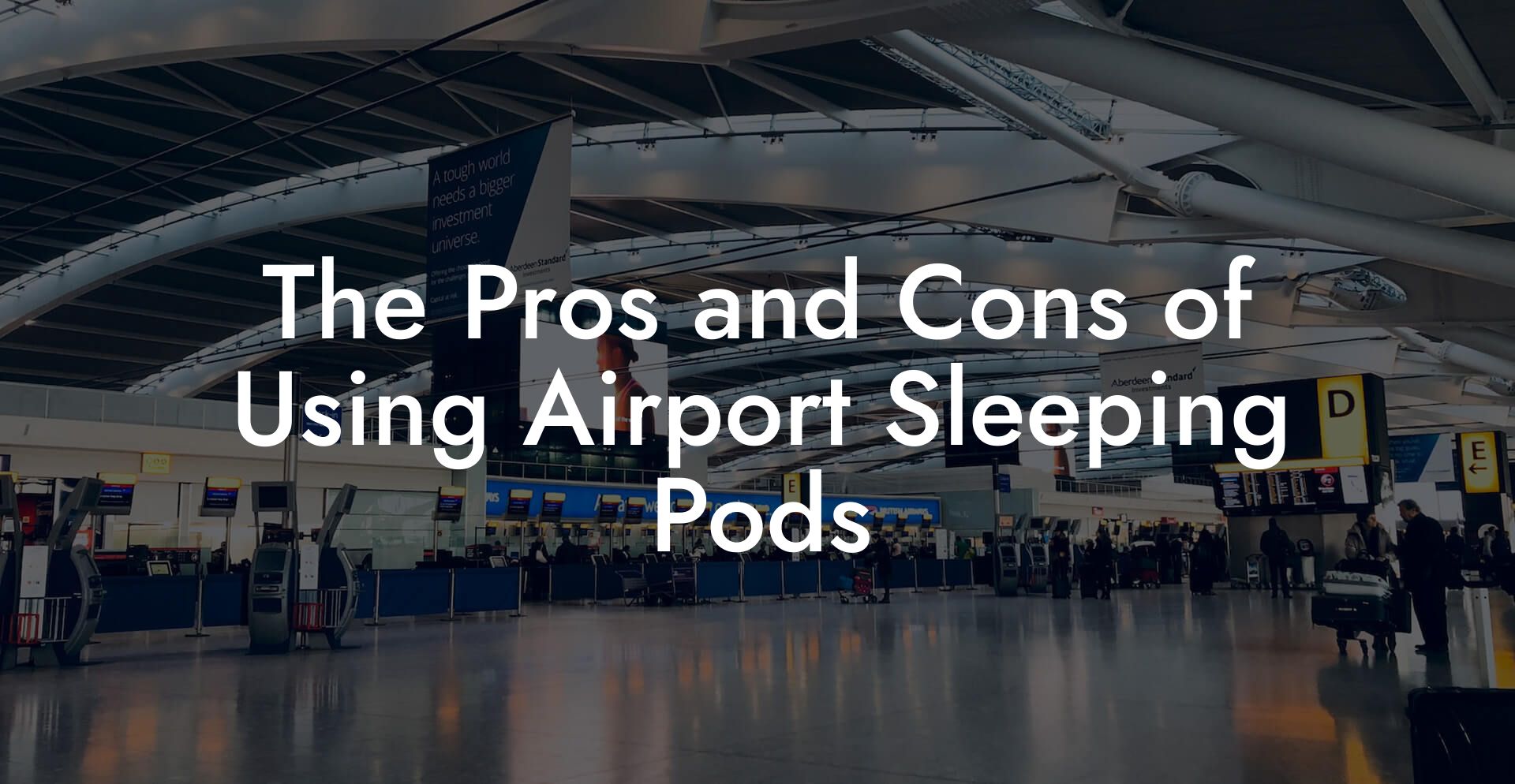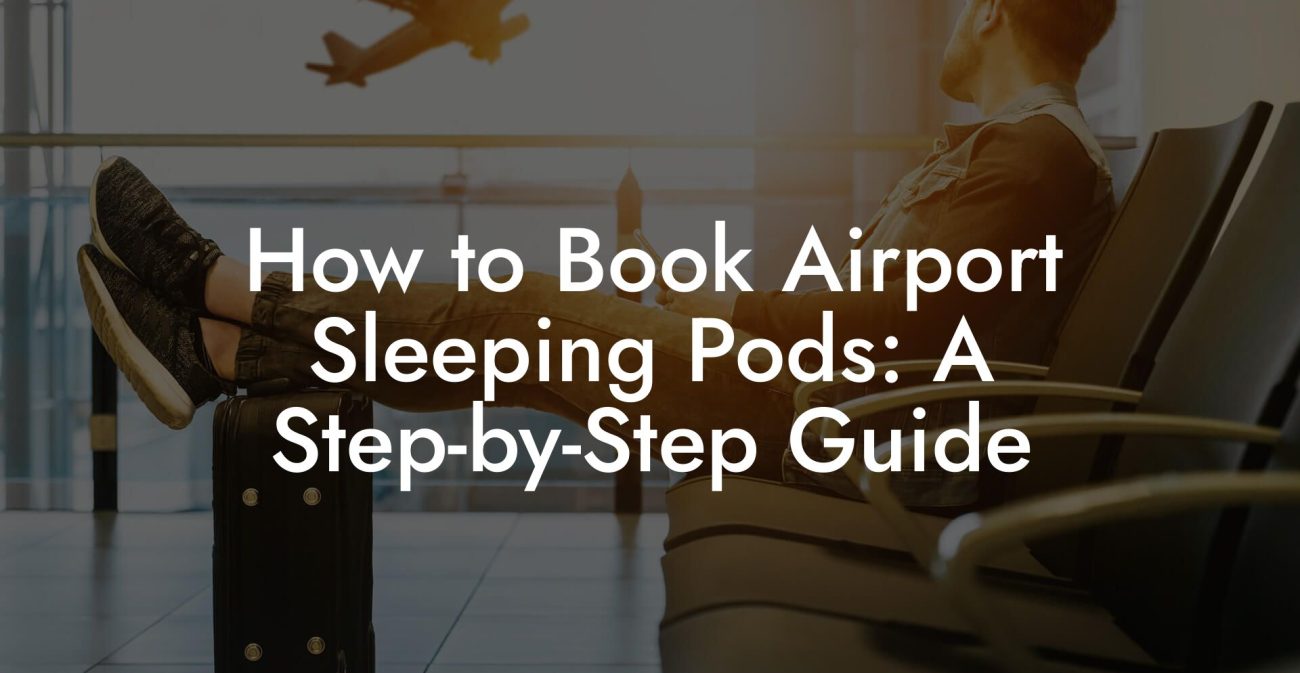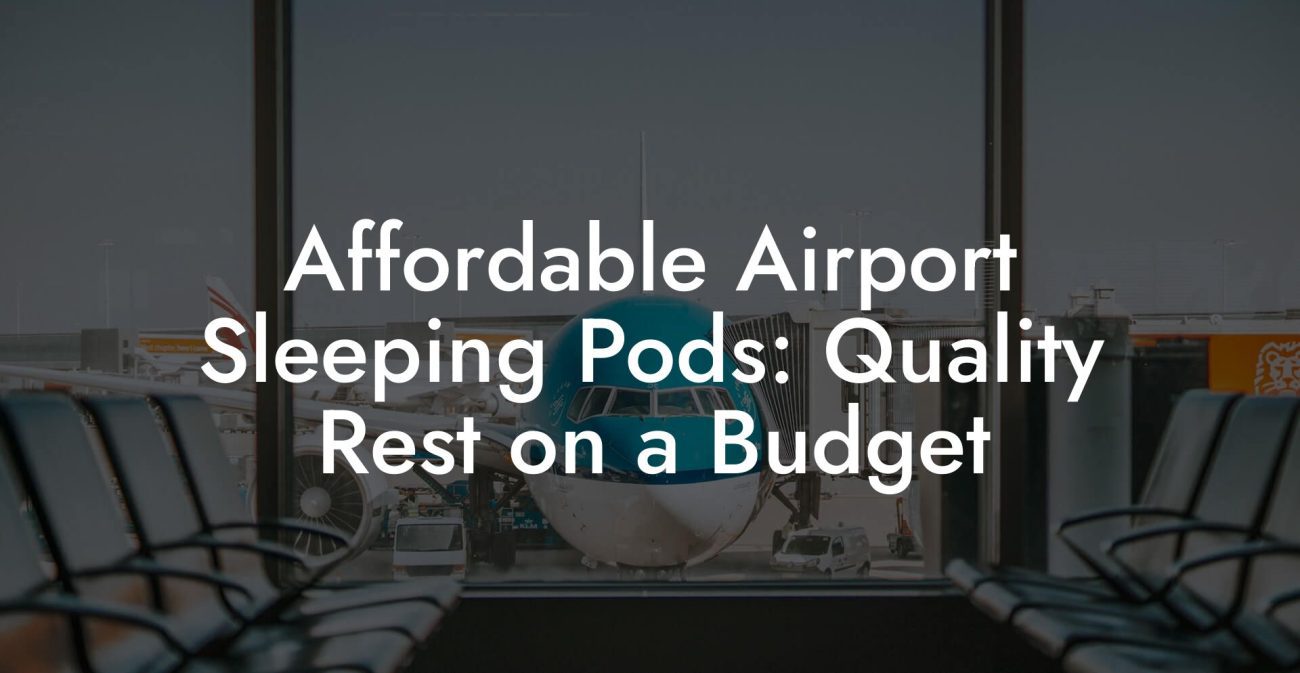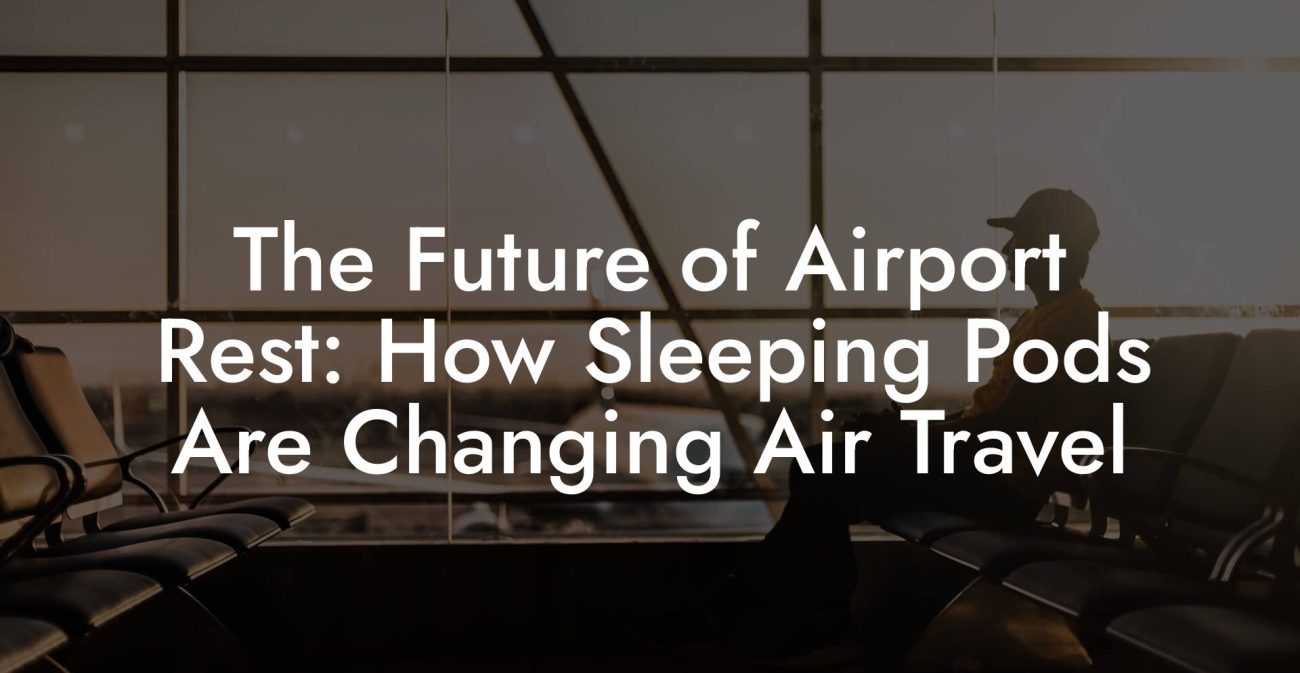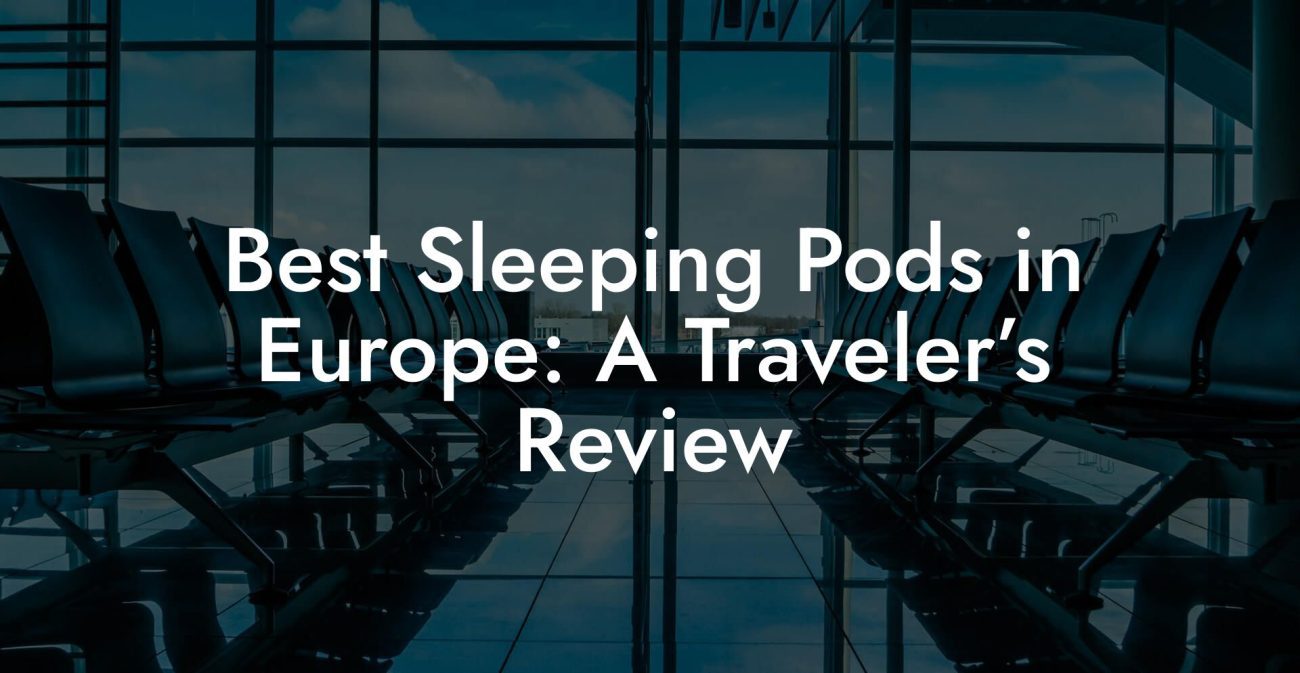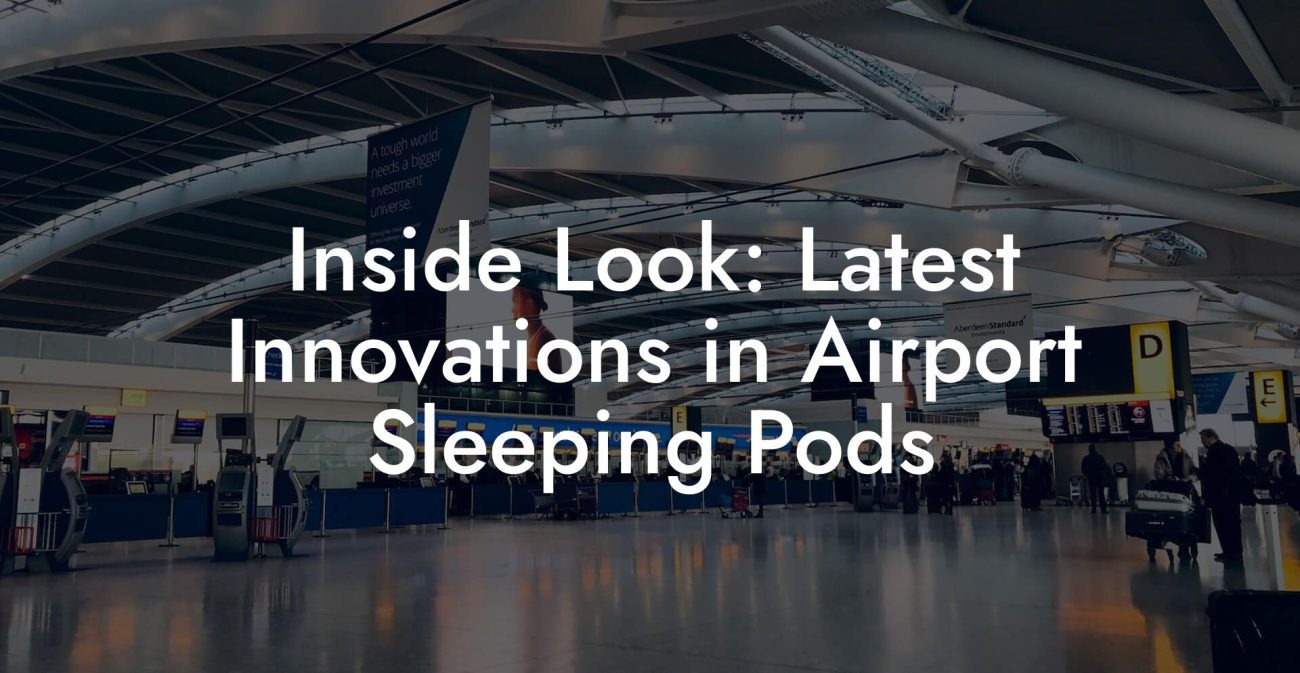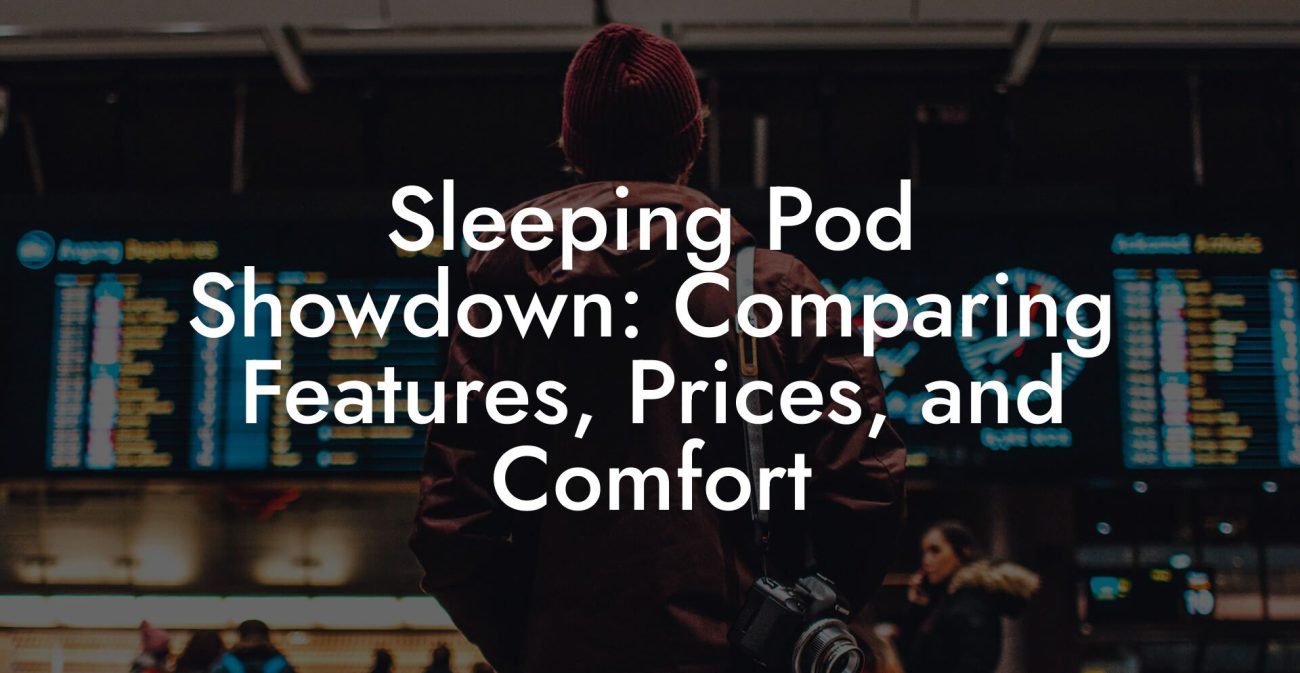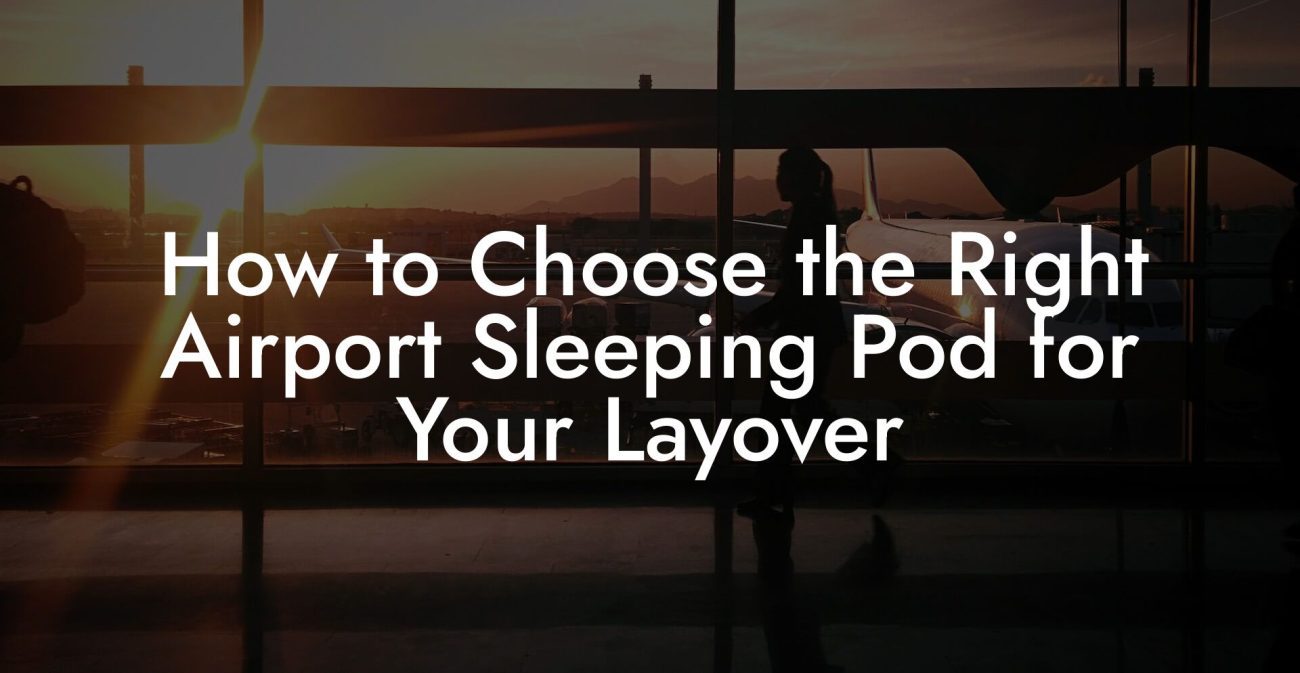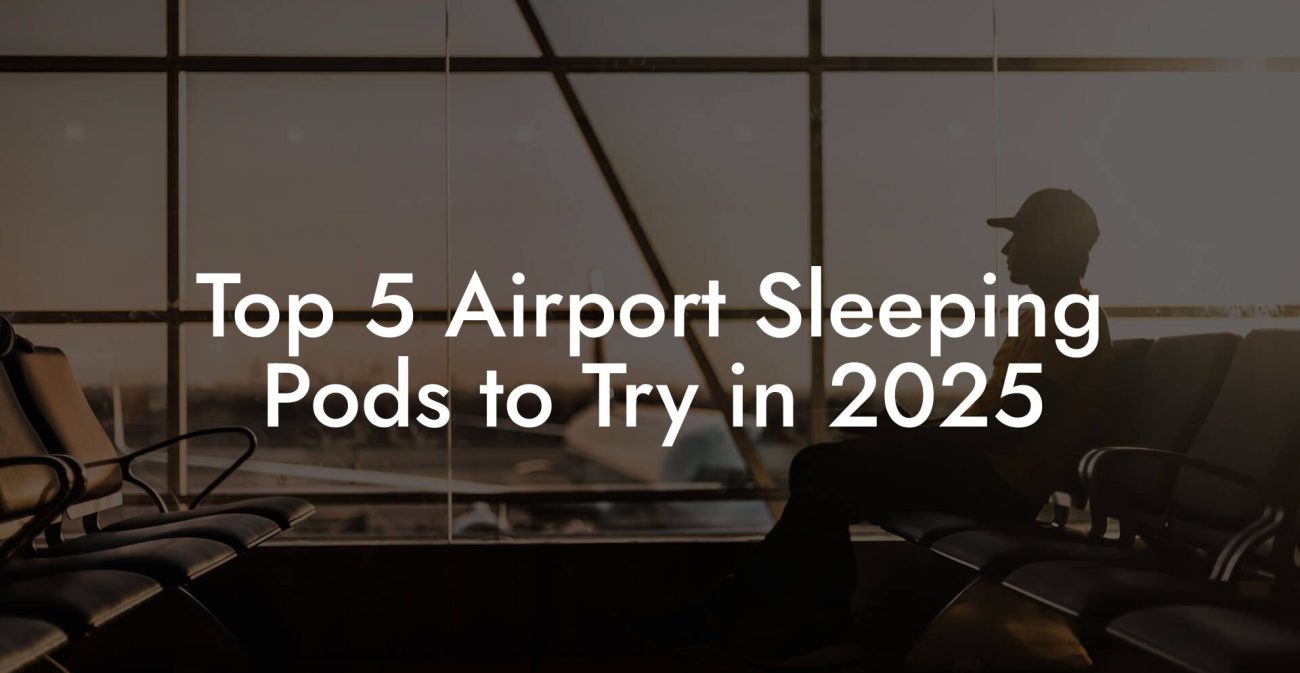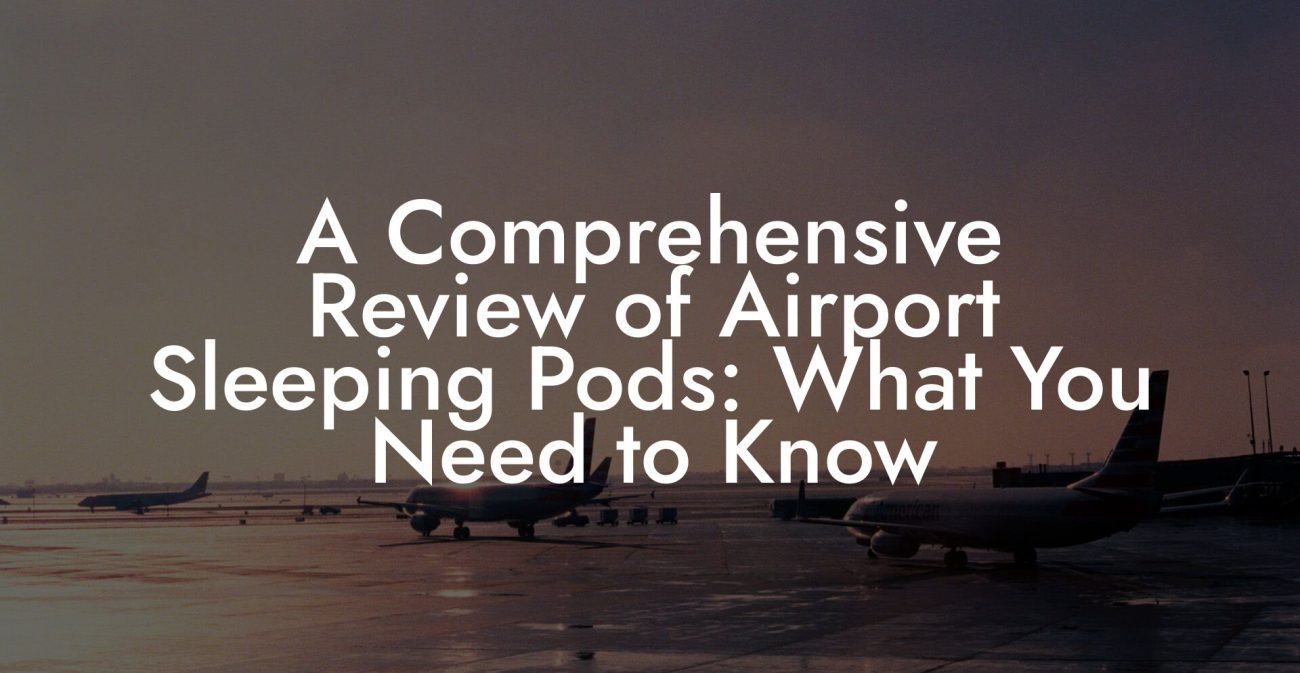Ever found yourself in a terminal at 3 a.m., drowning in a sea of uncomfortable chairs and endless announcements, wondering if there’s a better way to catch some Z’s on the go? Enter airport sleeping pods—a modern, high-tech solution that promises a slice of sanctuary in the midst of travel chaos. These futuristic havens are gaining traction among Gen-Z and millennial travelers looking for an affordable, secure, and sometimes surprisingly comfy way to reboot during layovers. But before you book your next terminal snooze, let’s unpack the real deal behind airport sleeping pods—their advantages, pitfalls, and everything in between.
Quick Links to Useful Sections
- What Are Airport Sleeping Pods?
- How Do Airport Sleeping Pods Work?
- The Pros: Benefits of Using Airport Sleeping Pods
- Enhanced Privacy and Security
- Optimized Sleep Environment
- Efficiency and Convenience
- Modern, Tech-Savvy Experience
- Stress Reduction and Productivity Boost
- The Cons: Drawbacks of Using Airport Sleeping Pods
- Limited Space and Comfort
- Cost Considerations
- Availability and Booking Challenges
- Hygiene and Maintenance Concerns
- Noise and Environmental Interruptions
- Comparing Airport Sleeping Pods with Traditional Airport Lounges
- Tech and Design Innovations in Airport Sleeping Pods
- Smart Environments
- Modular and Ergonomic Designs
- Integration of Connectivity Features
- Eco-Friendly Innovations
- Expert Tips for Maximizing Your Airport Sleep
- Pre-Book When Possible
- Create a Sleep-Conducive Ritual
- Pack Sleep Essentials
- Manage Your Time Wisely
- Stay Mindful of Hygiene
- Real-Life Experiences: Case Studies of Airport Sleeping Pod Users
- Case Study 1: The Business Traveler’s Lifesaver
- Case Study 2: The Budget-Savvy Backpacker
- Case Study 3: The Tech-Savvy Millennial
- Comfort, Cleanliness, and Convenience: User Reviews and Industry Insights
- User Reviews
- Industry Insights
- Comparing Costs and Value: Are They Worth It?
- Safety and Security Measures in Airport Sleeping Pods
- Access Control
- In-Pod Security Features
- Hygiene and Maintenance Protocols
- Resources and Community Support: Your Next Steps
- Future Trends: What’s Next for Airport Sleeping Pods?
- Balancing the Scales: When to Choose a Pod Over a Lounge
- Frequently Asked Questions About Airport Sleeping Pods
- Your Journey to a Restful, Tech-Enhanced Travel Experience
What Are Airport Sleeping Pods?
Airport sleeping pods are self-contained, cushioned capsules designed to offer a private space for catching some shut-eye during long layovers or delays. Unlike traditional airport lounges, these pods focus exclusively on providing a secured environment for sleep and relaxation. They often come equipped with features like adjustable lighting, charging ports, sound insulation, and sometimes even privacy curtains, making them the ultimate power nap station.
With the rising trend in on-the-go travel, these pods have become a game-changer. They cater primarily to the modern traveler who values efficiency, connectivity, and a dash of futuristic chic. By zoning in on the concept of sleep hygiene even when you’re between flights, airport sleeping pods aim to transform the dreaded airport wait into a more bearable—and even enjoyable—part of the travel experience.
Whether you’re a digital nomad sprinting between time zones or a wanderlust-stricken millennial looking for a quiet corner away from the bustling terminal, these pods could be your best bet for a much-needed rest. However, like any novel convenience, they come with their own set of advantages and challenges.
How Do Airport Sleeping Pods Work?
At their core, airport sleeping pods are designed to mimic the comfort and seclusion of a private hotel room, scaled down to fit within the limited space of an airport. Most pods operate on a pay-per-use model, where travelers can reserve a spot in advance or simply pay an hourly rate upon arrival. The booking process is typically integrated into a mobile app or self-service kiosk, making it both user-friendly and efficient.
Inside the pod, you’ll most often find a snug seat or flat surface that can recline into a bed-like position. Many models incorporate climate control features to adjust the temperature according to your preference, while some even include noise-cancelling elements or ambient sound machines to further boost your chances of a restful nap.
Security, of course, is paramount. These pods are usually locked and monitored within designated areas of the terminal, ensuring that your belongings and personal space are safeguarded while you rest. Additionally, innovative designs mean that the interior is well-insulated, providing a silent oasis amidst the relentless background hum of an airport.
Modern technology takes center stage with features such as USB charging ports, adjustable backrests, and occasionally integrated LED displays that double as both a clock and a wake-up alarm. It’s all about maximizing the little minutes you have while waiting for that next flight.
The Pros: Benefits of Using Airport Sleeping Pods
When it comes to sleeping in airports, versatility and convenience are the name of the game. Here’s why many travelers are turning to sleeping pods as their go-to solution for terminal fatigue:
Enhanced Privacy and Security
One of the most enticing benefits of airport sleeping pods is the sense of privacy they provide in an otherwise public space. Unlike sprawling, noisy waiting areas, pods offer a personal nook where you can relax without constantly peering over your shoulder.
For those concerned about the safety of their belongings, pods come with secure locking mechanisms and are often monitored by airport security, ensuring that your valuables remain just as undisturbed as your peace of mind.
Optimized Sleep Environment
Let’s face it—sleeping in uncomfortable airport chairs is hardly conducive to quality rest. Airport sleeping pods are designed with ergonomics in mind. Many feature adjustable seating, cushioned surfaces, and ambient lighting that can be dimmed to mimic nighttime conditions, all of which help to dial down the stress and ramp up the relaxation.
Some pods even provide options for white noise or soft tunes, making it easier to shut out the intermittent announcements and the general clamor of the terminal. This targeted focus on creating a sleep-friendly microenvironment can dramatically increase the quality of your rest.
Efficiency and Convenience
Time is money when you’re jet-setting. With the increasing prevalence of tight layover schedules, the ability to catch a quick power nap can be a real game-changer. Many travelers report that even a short 30-minute snooze in a sleeping pod leaves them feeling revitalized and ready to tackle the next leg of their journey.
The ease of booking and the hourly flexibility render these pods particularly attractive for frequent fliers. Plus, they’re typically located in prime areas within the airport, which means the time saved on commuting to a designated lounge can be reclaimed for a little extra sleep or even a quick shower.
Modern, Tech-Savvy Experience
For tech-enthusiasts and digital nativity aficionados, airport sleeping pods represent a perfect blend of comfort and technology. Integrated charging ports ensure that your devices are juiced up for your next outbound flight, while smart apps and digital interfaces streamline the booking and usage process.
The sleek designs and futuristic aesthetics also contribute to the overall travel experience, making these pods a trendy alternative to traditional airport seating.
Stress Reduction and Productivity Boost
Amid the relentless pace of modern travel, a restful pod can be your sanctuary. Quality rest isn’t just about recharging your body—it also reboots your mind. A well-timed nap can reduce stress and anxiety, helping you approach the next leg of your trip with renewed energy and clarity.
This increased alertness post-nap is a boon for business travelers and students alike, ensuring that whether you’re heading into a meeting or catching an online lecture, you’re functioning at peak efficiency.
The Cons: Drawbacks of Using Airport Sleeping Pods
While airport sleeping pods offer a modern solution to travel fatigue, they aren’t without their shortcomings. Here’s the flip side of the coin:
Limited Space and Comfort
Not all pods are created equal, and some designs may fall short in providing ample space for stretching or changing positions. For taller travelers or those who prefer a more spacious environment, the confined dimensions of a pod might feel more like a cocoon of discomfort than a restful retreat.
Similar to economy class seating, the limited space can sometimes result in awkward sleeping postures, potentially leading to aches and pains if used for extended periods.
Cost Considerations
While many travelers rave about the convenience of airport sleeping pods, the cost can add up—especially for those with multiple layovers or frequent travel. Pricing models vary widely by airport and provider, and what might seem like a reasonable hourly rate can quickly become an expensive perk if you’re using them regularly.
Budget-conscious travelers might find that the added expense isn’t justifiable, particularly if there are alternative rest areas available that, with a bit of creative positioning (and maybe a travel pillow), can offer similar comfort at a fraction of the cost.
Availability and Booking Challenges
The convenience factor can be compromised during peak travel hours. As these pods are a relatively new amenity, availability might be limited during high-traffic times, forcing some travelers to book well in advance—or settle for less-than-ideal wait times in case of last-minute needs.
Moreover, technical glitches or app-related issues during the booking process can add to the overall frustration, particularly when every minute in transit counts.
Hygiene and Maintenance Concerns
While airport authorities take hygiene seriously, some travelers express concerns regarding the cleanliness of these pods. Shared spaces in bustling airports can be challenging to maintain, and the high turnover of users sometimes leads to issues with sanitation.
For those with allergies or heightened sensitivity, this can mean worrying about allergens or unclean surfaces—a downside for any traveler who prioritizes a germ-free environment.
Noise and Environmental Interruptions
Despite their sound-insulated designs, airport sleeping pods are not completely immune to noise. The constant ebb and flow of ambient activity, periodic boarding announcements, and the occasional disruption from airport staff or fellow travelers can intrude on the sleep experience.
While many pods offer noise-masking features, the effectiveness varies by model and location, leaving some users questioning whether such investments truly translate to quality sleep.
Comparing Airport Sleeping Pods with Traditional Airport Lounges
When it comes to making the most of your airport downtime, both sleeping pods and traditional lounges offer unique benefits. However, they cater to different needs and preferences:
- Privacy: Pods are designed for one-on-one privacy, making them ideal for napping and short periods of isolated rest. Lounges, on the other hand, provide a communal space where travelers can network or simply relax in a more social environment.
- Amenities: While sleeping pods focus on sleep-enhancing features such as controllable lighting and integrated charging ports, lounges often offer additional perks like complimentary food, beverages, Wi-Fi, and even shower facilities.
- Cost: Airport lounges, especially those affiliated with airlines or accessible via premium memberships, can be quite pricey. Pods, while also charging an hourly rate, aim to provide a more affordable alternative for travelers merely in need of a short rest without the extra frills.
- Availability: Lounges are typically more abundant in major international airports, whereas sleeping pods might only be available in select terminals or newer facilities geared towards tech-savvy clientele.
Ultimately, the choice between a pod and a lounge often boils down to what kind of rest or experience you’re after. If you need a quick, uninterrupted power nap in a secure space, the pod might be your perfect match. But if you’re looking for a holistic travel experience complete with gourmet snacks and a dash of luxury, the lounge might take the cake.
Tech and Design Innovations in Airport Sleeping Pods
The evolution of airport sleeping pods is a testament to how technology and smart design can transform even the most mundane spaces into havens of relaxation. Let’s take a deeper dive into some of the groundbreaking features that make these pods a standout option:
Smart Environments
Many pods now incorporate sensors and smart automation to adapt the environment to your needs. Temperature control, adjustable lighting, and even air quality monitoring are tailored to create the ideal nap conditions at the touch of a button.
With smartphone integration, you can customize your pod experience through dedicated apps. Imagine booking your pod, adjusting the ambient settings, and even receiving a wake-up alert—all within a few taps on your device.
Modular and Ergonomic Designs
The design of these pods is more than just futuristic aesthetics; it’s about optimizing every square inch to promote comfort and ergonomic support. Developers are constantly refining these designs based on user feedback to ensure that the seating, bedding, and overall spatial layout reduce physical strain.
Some models even incorporate memory foam and adjustable backrests that contour perfectly to the human body, providing tailored support for longer durations. This level of customization not only enhances comfort but also minimizes the risk of backaches and stiffness after a short nap.
Integration of Connectivity Features
In today’s hyper-connected world, no traveler wants to leave their devices behind—especially when they’re the lifelines to work and social connections. That’s why many pods offer multiple USB ports, wireless charging pads, and even high-speed Wi-Fi access to keep you connected while you rest.
This integration of tech ensures that your downtime doesn’t mean business downtime, a feature particularly celebrated among professionals who need to check emails or partake in last-minute digital meetings.
Eco-Friendly Innovations
As sustainability becomes every traveler’s mantra, some providers are embracing eco-friendly materials and energy-efficient designs. Energy-saving LED lighting, biodegradable materials for interiors, and smart power management systems are just a few examples of how these pods are taking steps towards a greener future.
These eco-conscious decisions not only appeal to environmentally aware travelers but also underline a broader commitment to sustainable innovation in the aviation industry.
Expert Tips for Maximizing Your Airport Sleep
Securing a pod is only half the battle—knowing how to make the most of your limited sleep time is where the real magic lies. Here are some practical tips to ensure you awake refreshed and ready to tackle your journey:
Pre-Book When Possible
With the increasing popularity of sleeping pods, especially during peak travel seasons, it pays to plan ahead. Use dedicated apps or online booking tools to reserve your pod in advance. Doing so minimizes the stress of search-and-find last minute, ensuring a spot is waiting for you upon arrival.
Create a Sleep-Conducive Ritual
Even though you’re in a busy airport, a short pre-sleep routine can help signal to your body that it’s time for rest. Put on your noise-cancelling headphones, switch to a calming playlist or ambient sounds, and adjust the lighting to your comfort level. These little rituals can make a big difference in the quality of your sleep.
Pack Sleep Essentials
Don’t leave your sleep toolkit at home. A travel pillow, a cozy blanket, and even an eye mask can complement the pod’s amenities, making you feel even more at home in that confined space. For dubbed light sleepers, earplugs or a pair of noise-cancelling headphones can be essential equipment for a quiet retreat.
Manage Your Time Wisely
While catching a nap is beneficial, it’s also important not to oversleep—especially when you’ve got a connecting flight. Set an alarm if the pod doesn’t have a built-in wake-up feature, and give yourself ample time to freshen up and head to your gate.
Stay Mindful of Hygiene
Airport sleeping pods are shared spaces, so it’s wise to carry a small travel kit of disinfecting wipes or hand sanitizer. Wipe down the surfaces around you before settling in for a nap, and keep your personal belongings close at hand to maintain a clean, personalized environment.
By adopting these expert tips, you’ll be not only optimizing your sleep quality but also ensuring that the overall travel experience remains as stress-free as possible.
Real-Life Experiences: Case Studies of Airport Sleeping Pod Users
Nothing illustrates the pros and cons of airport sleeping pods better than real-life experiences. Let’s dive into a few case studies that capture the authentic vibes of these futuristic sleep stations:
Case Study 1: The Business Traveler’s Lifesaver
Sarah, a young marketing executive who frequently hops between international meetings, was initially skeptical about the pods. After a particularly grueling 10-hour layover in a bustling hub, she decided to try one out. With its adjustable backrest, ambient lighting, and reliable charging outlets, the pod became her go-to sanctuary. The brief, restorative nap not only helped her avoid jet lag, but also allowed her to polish off some last-minute work emails—all without having to leave her dedicated sleep zone.
Sarah’s experience underscores how the pods can blend rest with productivity, making them perfect for busy professionals who need both downtime and connectivity.
Case Study 2: The Budget-Savvy Backpacker
Jake, a perpetual globetrotter on a shoestring budget, discovered airport sleeping pods on a whim while passing through an airport in Southeast Asia. Although the initial cost seemed steep compared to crashing on a bench, the benefits of security, privacy, and actually feeling rested convinced him. Jake was able to catch a rejuvenating nap without worrying about his backpack or personal items, proving that sometimes a little extra investment yields exponential returns in comfort and peace of mind.
His story is a testament to how even budget-conscious travelers can benefit from using pods as a strategic sleep hack during long layovers.
Case Study 3: The Tech-Savvy Millennial
Emily, a tech influencer and self-proclaimed gadget geek, was drawn to the advanced features and sleek design of the airport pod she tried at a major U.S. airport. With smart connectivity that linked seamlessly to her mobile device, she was able to customize every aspect of her pod experience—be it setting the right temperature or scheduling her wake-up time precisely. Emily raved about how the digital interface not only made the process innovative but also ensured that she could maintain uninterrupted access to her social media streams once she woke up.
Her experience serves as a glowing endorsement for those who love blending technology with travel, highlighting that comfort and connectivity can coexist in perfect harmony.
These stories, varied as they are, offer a well-rounded view of what different types of travelers can expect. Each case study reflects personal priorities, from enhanced productivity to cost-effectiveness, and even to pure tech indulgence, making it clear that airport sleeping pods cater to a diverse range of needs.
Comfort, Cleanliness, and Convenience: User Reviews and Industry Insights
While travelers’ experiences speak volumes, industry experts have weighed in on the emerging trend of airport sleeping pods. Here’s what you need to know:
User Reviews
Across social media platforms and travel forums, user reviews for airport sleeping pods show a blend of enthusiasm and constructive feedback. Many praise the privacy and security features, along with the ease of booking through intuitive mobile apps. Compliments often mention waking up feeling more refreshed compared to a night on a hard bench or in a crowded lounge.
However, some users have raised concerns regarding the limited space for stretching out and occasional discrepancies in maintenance and cleaning standards. These insights suggest that while the concept is promising, there’s still room for growth in meeting universal comfort standards.
Industry Insights
Industry experts believe that airport sleeping pods are part of a larger trend towards maximizing passenger comfort and creating micro-environments tailored specifically for rest and productivity. Future innovations are expected to address current limitations—improving space usage, enhancing sanitation protocols, and integrating even more advanced connectivity and customization features.
As airports continue to evolve into multi-functional hubs, the incorporation of sleep pods alongside traditional lounges could redefine the way we view airport downtime. With industry players investing in R&D and startups entering the market, the future definitely looks promising for travelers seeking a peaceful refuge in the midst of travel mayhem.
Comparing Costs and Value: Are They Worth It?
One of the perennial questions for any modern travel amenity is, “Are you really getting your money’s worth?” Let’s compare the cost of airport sleeping pods with the alternatives:
- Hourly Rental Rates: Pods typically charge by the hour, with rates varying based on location, time of day, and pod features. For those who only need a brief power nap, this cost can be a practical investment compared to booking a day pass at a busy lounge.
- Alternative Options: Traditional relaxation options such as reclining chairs or free waiting areas may be available, but often lack the security and personalized comfort features of a pod. Moreover, the cumulative toll on your health from poor sleep in ill-equipped spaces could be far costlier in terms of energy and productivity.
- Bundled Perks: Some airport sleeping pods are part of a broader ecosystem offering value-added services like direct access to showers, mini workstations, or additional privacy enhancements. These extras might justify a higher price tag for the traveler who desires a fully integrated rest experience.
Ultimately, the decision hinges on your travel style, budget flexibility, and how much you value a quantifiable improvement in comfort and productivity. For frequent fliers, the marginal cost could be considered an investment in overall travel well-being.
Safety and Security Measures in Airport Sleeping Pods
In an era where personal security is paramount, airport sleeping pods also emphasize your safety during your rest period. Here’s a closer look at the safety and security protocols typically implemented:
Access Control
Most pods are situated in designated areas within the terminal, accessible only via secure doors and monitored by airport security personnel or surveillance cameras. This minimizes the risk of unauthorized entry and ensures that only paying customers are privy to the space.
In-Pod Security Features
Additional safety measures within the pods include lockable storage compartments, alarm systems, and even emergency call buttons that connect you directly with security staff. These features help maintain both physical safety and peace of mind while you sleep.
Hygiene and Maintenance Protocols
With the heightened focus on health safety, many providers have adopted stringent cleaning protocols. Regular sanitization, especially between users, ensures that the environment inside the pods meets contemporary hygiene standards, a particularly vital feature in a post-pandemic travel landscape.
The emphasis on safety extends beyond physical measures, incorporating digital security as well—ensuring that the booking and usage data remains confidential and secure.
Resources and Community Support: Your Next Steps
Are you ready to embrace the future of travel sleep? Whether you’re a frequent flyer curious about the latest travel trends or a cautious explorer looking for that perfect pit stop between flights, there’s a wealth of resources and community support out there.
Online Communities: Platforms like Reddit, travel blogs, and dedicated travel forums have buzzing discussions around airport sleeping pods. These communities provide real-time reviews, practical advice, and local insights about the best airports to try out pods or alternative nap solutions.
Mobile Apps and Booking Platforms: Many airports now integrate pod booking options directly into their apps. These tools not only let you reserve a pod but also offer user ratings, detailed feature lists, and even virtual tours to help you make the best choice.
Expert Reviews and Travel Guides: Trusted travel influencers and experts continuously review new amenities, including sleeping pods. Keep an eye on travel magazines and YouTube channels for in-depth analysis and comparisons.
Airport Websites and Customer Service: Check out the official websites of major airports to see if they offer sleeping pods or similar rest-associated technologies. Many airports provide updated information on service availability, pricing, and additional amenities.
By connecting with these resources and communities, you can make informed decisions and join a vibrant network of travelers dedicated to making every airport experience as comfortable as possible.
Future Trends: What’s Next for Airport Sleeping Pods?
As technology and travel converge in ever more inventive ways, the future of airport sleeping pods looks poised for exciting developments. Experts predict innovations that will further blur the line between digital connectivity and personal comfort.
Expect to see pods with augmented reality interfaces that display immersive relaxing visuals, personalized sleep profiles that automatically adjust the pod settings based on your sleep data, and even integration with wearable technology to monitor your sleep quality in real time.
Moreover, as sustainable design continues to gain ground, more eco-friendly materials and energy-efficient systems will likely become standard. These innovations not only cater to the tech-savvy traveler but also address the broader environmental concerns that motivate today’s responsible globetrotters.
As airports evolve into multi-functional hubs that prioritize passenger well-being, sleeping pods stand at the frontier—combining privacy, technology, and design to meet the unique demands of modern travel.
Balancing the Scales: When to Choose a Pod Over a Lounge
Deciding whether to opt for an airport sleeping pod or a traditional lounge comes down to personal priorities. If you prioritize a quiet, private space for a quick power nap and are willing to pay a little extra for the security and modern tech features, a pod could be your best bet. They’re ideal for travelers who need minimal distractions and want to recharge effectively before their next flight.
On the other hand, if you’re looking for more social interaction, additional dining options, and a broader range of facilities including showers and relaxation areas, a lounge might suit you better. It’s all about assessing your specific needs, travel budget, and the amount of downtime you have available.
Both options have their merits, and sometimes even combining them—using a pod for a quick bed and a lounge for a leisurely meal—can provide the ultimate travel experience.
Frequently Asked Questions About Airport Sleeping Pods
The following FAQ section is designed to address the most common questions travelers have about airport sleeping pods. Whether you’re curious about booking, features, or overall user experience, these answers provide a clear insight.
1. What exactly are airport sleeping pods, and how do they work?
Airport sleeping pods are compact, secure spaces located within airports, designed to offer travelers a private place to rest. Typically available on a pay-per-use basis, the pods are equipped with ergonomic seating that can convert into a sleeping surface, adjustable lighting, charging ports, and sometimes even privacy curtains and noise-cancelling features.
2. How do the costs of airport sleeping pods compare to traditional airport lounges?
Pods are generally priced on an hourly basis and are often more affordable than premium lounge memberships or day passes. However, costs can vary by location and the specific features provided, so it’s always best to review the pricing details at the airport you’re visiting.
3. Are airport sleeping pods safe and secure?
Yes, safety is a top priority in the design of airport sleeping pods. They are typically located in secure areas of the airport, often monitored by security cameras and staff, and include in-pod security features like lockable storage compartments and emergency call buttons.
4. Is it really comfortable to sleep in such a small space?
Comfort levels can vary by pod design. Many users find that the ergonomic design and adjustable settings make for a restful experience, though taller travelers or those who require extra space might find some pods a bit too confining.
5. Can I charge my devices while using a sleeping pod?
Absolutely. Most sleeping pods are equipped with USB charging ports and sometimes even wireless charging pads, ensuring that you can keep all your devices charged and ready for your next flight.
6. How do I find and book a sleeping pod at an airport?
Many airports now offer integrated booking services through their mobile apps or kiosks. Additionally, third-party services and review platforms often provide real-time availability and user feedback to help you choose the best option.
7. What steps are taken to maintain hygiene in these pods?
Providers usually adhere to strict cleaning protocols, including regular sanitization between users, especially in high-traffic areas. It’s also a good idea to carry disinfecting wipes or hand sanitizer to give the surfaces a quick wipe down before you settle in.
8. Are there any futuristic features I should look forward to?
Yes, innovation in airport sleeping pods is ongoing. Future enhancements include smart environment controls, personalized sleep settings through wearable tech integrations, and even augmented reality interfaces to create a more immersive relaxation experience.
Whether you’re a seasoned traveler or trying out this concept for the first time, the increasing array of options and features means there’s never been a better time to explore the benefit of catching some sleep in an airport pod.
Your Journey to a Restful, Tech-Enhanced Travel Experience
In a world where travel is as much about the journey as it is about reaching a destination, airport sleeping pods represent a bold step forward. They merge modern technology with practical design to transform the mundane waiting period into a rejuvenating pause in your day. Whether it’s the unparalleled privacy, the tech-savvy features, or the commitment to creating a near-hotel level of comfort, these pods have sparked a whole new way to travel.
Yet, mindful of the drawbacks like limited space and sometimes unpredictable hygiene standards, the choice to use an airport sleeping pod ultimately comes down to your travel needs and lifestyle. For many, the advantages far outweigh the disadvantages, turning a potentially stressful wait into a measured, restorative experience.
As you navigate the ups and downs of modern air travel, consider your priorities—be it ample connectivity, high-tech comfort, or simply a secure place to catch some Z’s. There’s a whole community of travelers out there experimenting with these innovations, sharing tips, and refining what it means to travel smart in the digital age.
With new trends emerging and continuous improvements anticipated, the future of airport sleeping pods looks bright. So, the next time you’re faced with a long layover, take a moment to consider this modern sleep solution. It might just be the best travel hack you ever discover—a restful retreat that not only recharges your body but also arms you with the mental clarity needed to conquer your next adventure.
Embrace the blend of technology, design, and comfort. Enjoy a journey where every moment counts, even the time spent powered down. Your quest for a better travel experience begins with one small step—a reservation for an airport sleeping pod that could transform your layover into a revitalizing oasis.
Useful Interruption: Dive deeper into the world of airport sleeping guides with our most popular sections. If there is anything you think is missing or anything you would love for us to write about, just give us a shout.
- General Airport Sleeping Guides
- Travel Gear & Equipment Recommendations
- Regional and Airport-Specific Guides
- Airport Sleeping Pods & Reviews
- Health, Safety, and Comfort Tips for Airport Sleepers
Last week, I decided to try the world-famous "airport sleepover" experience. Imagine this: I'm lying on a bench in Terminal C, surrounded by suitcases that have seen more of the world than I ever will, and a PA system that sounds like a karaoke machine on a sugar rush. I pull out my travel pillow—which, by the way, is more like a sad deflated balloon—and declare, "Tonight, I’m the king of this terminal!"
Soon enough, fellow travelers become my unexpected audience. One guy, fresh off a red-eye, whispers, "Hey, do you think if we sleep long enough, we can catch our flight in our dreams?" I reply, "Sure, and maybe I'll even get an upgrade to first-class in my nap!" The airport lights flicker like a disco ball, and every time someone announces a delayed departure, it’s like a punchline to our impromptu stand-up routine.
As I finally drift off, I dream of a world where boarding passes are like VIP tickets to the best sleepover party ever—a party where the only baggage is the laughter you carry with you. Waking up, I realize the airport is still the same, but I now hold the honorary title of "Terminal Comedian," a title I wear with as much pride as my permanently mismatched socks!

